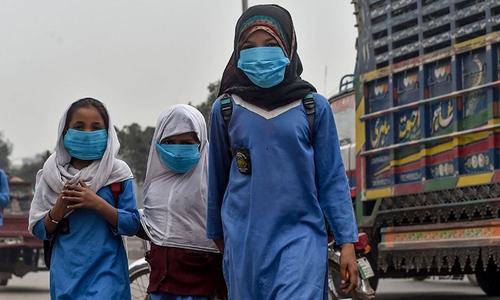As much of the world grapples with the Covid-19 pandemic, the World Health Organisation (WHO) has declared an “infodemic” — an over-abundance of information, some accurate and some not — that makes it hard for people to find trustworthy sources and reliable data.
The internet is inundated with coronavirus misinformation with people sharing unverified claims about where the virus came from, its symptoms, prevention, and misleading updates.
To access accurate information, here is what you can do:
Find the source
Before you forward a message, first identify where it came from. Often viral messages are labelled ‘forwarded’ on WhatsApp or copy-pasted across social media platforms.
For instance, Dawn recently fact-checked a fake notification that was doing the rounds on social media, claiming that Pakistan’s health ministry had suggested that a prevention method was to keep one's throat moist.

Official public advisories mention no such precaution related to the throat and advise measures such as maintaining personal hygiene, wearing masks, and avoiding contact with people who are ill.
When traced online by a simple copy-paste of the text on Facebook, Dawn found multiple users had copy-pasted the same message across social media platforms around the world — and was also debunked by authorities in Canada and India.
Also read: Chloroquine and coronavirus — what is the connection?
Know where to access reliable information
When everyone you know is sharing updates on coronavirus, the rule is to limit your trusted sources of information.
For global updates, the most reliable source of information is the WHO. If you have a question about Covid-19, add +41798931892 number to your contacts, and chat with the WHO.
Currently, this bot provides you with the latest numbers across the world related to the pandemic, tips and FAQs on the disease, myths surrounding Covid-19, travel advice, and latest news from the health organisation.
To access accurate information about the outbreak in Pakistan, follow real-time updates on the Covid-19 dashboard (http://covid.gov.pk/) run by the Ministry of National Health Services Regulations and Coordination.
The national health helpline is 1166.
For provincial updates, refer to Sindh government’s ‘Gos-Covid19’ (@19Sindh) account on Twitter, and Khyber Pakhtunkhwa’s @HealthKPGovt account on Twitter and Facebook, and Balochistan Health Department @HealthDeptBlo on Twitter.
Is the graphic fake?
From screenshots of TV tickers to create panic, to the use of distorted videos to falsely show patients collapsing in China, manipulation of graphics is a common method of disseminating misinformation.
For example, a screenshot of a purported internal email disclosing that a bank in Rawalpindi was closed after an employee tested positive for the novel coronavirus has been shared on Facebook, Twitter and WhatsApp.
French news agency AFP found that the claim is false; the bank said in a statement that no employee at any of its branches had tested positive for Covid-19, and that all branches remained open and fully operative.
Original graphic content is mostly easy to find online — on government websites, official accounts, and news outlets. If you cannot find it on official channels, it is most likely not worth sharing until verified.

Look out for debunks
Everyone is confused right now. The solution lies in addressing the confusion.
The next time you receive a hoax or prevention tip on a WhatsApp group, instead of engaging, counter the concern with evidence-based information.
A text message claiming that special military helicopters will spray pesticides at midnight to combat the spread of coronavirus has been doing rounds on social media.
For those who actually believe it, the army’s media wing, the Inter-Services Public Relations (ISPR), has clarified that the information is not true.
Sharing clarifications by official authorities can help build trust during an uncertain time.
For journalists and consumers of social media, international organisation First Draft has built a searchable archive of fact-checked mis- and disinformation on coronavirus from around the world. The database includes debunks in more than 20 languages which are searchable in English.
Identify biases
Misinformation thrives when there is an absence of verified facts and it is human nature to try to make sense of new information based on what we already know.
This is the reason why desi totkas and popular remedies such as garlic, saltwater, onions, lemon juice, and ginger have all featured in viral posts as treatments from people who are often just looking out for their friends and family.
In Iran, where alcohol is illegal and thousands have been infected, 44 people died and hundreds were hospitalised after drinking home-made booze to protect against the disease, according to Iranian media.
Be responsible, not emotional.
Not sure? Don’t share
Finally, if you are unsure if the content is true, do not forward it to friends or other groups.
We all play a role in stopping the spread of the virus and viral hoaxes.














































